Development of Grouting Test System for Rough Fissure Rock Body and Research on Slurry Diffusion Law
Abstract
:1. Introduction
2. Theoretical Analysis of Temporal and Spatial Patterns of Rough Fracture Slurry Pressure
3. Development of a Simulated Grouting Diffusion Experiment Device for Rough Fractures
3.1. Rock Grouting Module
3.2. Rough Fracture Seepage System
3.3. Data Processing Module
3.4. The Technical Advantages of This Experimental System
- (1)
- The existing rough crack test system has a small width and size, as in reference [31]. The entire test setup measures 100 mm × 2 mm; this leads to an approximation of slurry flow as unidirectional, with the presence of boundary layer effects, which significantly deviates from the actual scenario of slurry radially spreading in all directions. Consequently, it is challenging to accurately represent the real on-site slurry diffusion.
- (2)
- The test system can simulate the flow of different fluids, including slurry, water and air, within rough fractures, and it can also be used to investigate the displacement mechanisms between various fluids.
- (3)
- The test system can simulate the impact of various parameters, such as different fracture roughnesses, fracture apertures, grouting pressures and fracture inclinations, on the flow behavior of slurry. It has a wide range of applications in experiments.
3.5. Reliability Verification of Grouting Test Device
4. Analysis of Experimental Results
4.1. Analysis of Fracture Roughness on Slurry Diffusion Law
4.2. Analysis of Fracture Opening on Slurry Diffusion Law
4.3. Analysis of Slurry Pressure Distribution Law by Grouting Pressure
4.4. Comparative Analysis with Previous Studies
5. Discussion of Slurry Diffusion Behavior in Rough Fractures and Analysis of Field Applications
- (1)
- When the fracture aperture is relatively small, the roughness of the fracture will have a more pronounced effect on slurry flow. Slurry is less likely to flow within the fractures. Using a higher grouting pressure at this point can lead to local vortex phenomena due to excessive flow velocity, causing increased resistance losses along the path, which may not be conducive to slurry diffusion. Therefore, in the case of small fracture apertures, using a lower grouting pressure for construction will yield better grouting results.
- (2)
- When the fracture roughness is relatively high, as indicated by the earlier analysis, lower grouting pressure should be used for construction. Conversely, using a higher grouting pressure will better meet the actual grouting requirements.
- (3)
- When the fracture roughness is relatively high, as indicated by the earlier analysis, a lower grouting pressure should be used for construction. Conversely, using a higher grouting pressure will better meet the actual grouting requirements.
6. Conclusions
- (1)
- The diffusion behavior in rough fractured rock masses is primarily influenced by the combined effects of grouting pressure, fracture aperture, and fracture roughness. We developed a theoretical model of slurry diffusion considering parameters such as grouting pressure, crack aperture and crack roughness.
- (2)
- We independently developed a grouting test apparatus for rough fractured rock masses and conducted slurry diffusion experiments under different fracture roughness conditions, fracture apertures, and grouting pressures. The experimental results differed from the theoretical results by only 12%, indicating the high reliability of this test apparatus.
- (3)
- Analysis of the experimental results revealed a nonlinear positive relationship between fracture aperture and fracture roughness on slurry pressure. Grouting pressure exhibited a linear positive relationship with slurry pressure. We also conducted an analysis of the slurry diffusion behavior in rough fractured rock and provided relevant construction techniques for on-site applications.
- (4)
- This paper discusses the slurry diffusion behavior in rough fractured rock and, through grouting applications in the coal mine tunnel surrounding rock, optimizes the grouting process. The tunnel surrounding rock deformation was reduced to 3mm/day, ensuring safe and efficient coal mining operations.
Author Contributions
Funding
Institutional Review Board Statement
Informed Consent Statement
Data Availability Statement
Conflicts of Interest
References
- Jia, H.; Li, X.; Lu, L.; Ma, Q.; Zhang, P.; Zhong, Y. Study on simulation method for planar fracture grouting of expansive polymer grout based on polymerization reaction mechanism. China Civ. Eng. J. 2022, 55, 50–61. (In Chinese) [Google Scholar]
- Gao, M.; Zhang, R.; Xie, J.; Peng, G.; Yu, B.; Ranjith, P. Field experiments on fracture evolution and correlations between connectivity and abutment pressure under top coal caving conditions. Int. J. Rock Mech. Min. 2018, 111, 84–93. [Google Scholar] [CrossRef]
- Shang, Y.; Kong, D.; Pu, S.; Xiong, Y.; Li, Q.; Cheng, Z. Study on Failure Characteristics and Control Technology of Roadway Surrounding Rock under Repeated Mining in Close-Distance Coal Seam. Mathematics 2022, 10, 2166. [Google Scholar] [CrossRef]
- Hou, G.; Zhou, Y.; Zhao, T.; Tan, J.; Zhao, Q.; Huang, J. Excavation unloading response of cylindrical rock-like specimen with axial joints: Laboratory experiment and numerical simulation. J. Geophys. Eng. 2023, 20, 21–37. [Google Scholar] [CrossRef]
- He, Z.; Xie, Z.; Zhang, N.; Han, C.; Xiang, Z.; Yan, G.; Qiao, H.; Shao, C. Research on spatiotemporal evolution law of surrounding rock fractures and hierarchical collaborative control technology in high-stress soft rock roadway: A case study. Eng. Fail. Anal. 2023, 150, 107366. [Google Scholar] [CrossRef]
- Weng, L.; Wu, Z.; Zhang, S.; Liu, Q.; Chu, Z. Real-time characterization of the grouting diffusion process in fractured sandstone based on the low-field nuclear magnetic resonance technique. Int. J. Rock Mech. Min. 2022, 152, 105060. [Google Scholar] [CrossRef]
- Zhang, E.; Xu, Y.; Fei, Y.; Shen, X.; Zhao, L.; Huang, L. Influence of the dominant fracture and slurry viscosity on the slurry diffusion law in fractured aquifers. Int. J. Rock Mech. Min. 2021, 141, 104731. [Google Scholar] [CrossRef]
- Huang, S.; Pei, Q.; Ding, X.; Zhang, Y.; Liu, D.; He, J.; Bian, K. Grouting diffusion mechanism in an oblique crack in rock masses considering temporal and spatial variation of viscosity of fast-curing grouts. Geomech. Eng. 2020, 23, 151–163. [Google Scholar] [CrossRef]
- Zhai, M.; Ma, D.; Bai, H. Diffusion Mechanism of Slurry during Grouting in a Fractured Aquifer: A Case Study in Chensilou Coal Mine, China. Mathematics 2022, 10, 1345. [Google Scholar] [CrossRef]
- Hu, Y.; Liu, Z.; Gao, K.; Liang, D.; Cheng, S. Diffusion mechanism and sensitivity analysis of slurry while grouting in fractured aquifer with horizontal injection hole. Carbonates Evaporites 2020, 35, 49. [Google Scholar] [CrossRef]
- Xu, R. Flow capacity characterization of unconventional natural gas bearing rocks using digital rock physics: A comparison between advection and diffusion. J. Petrol. Sci. Eng. 2022, 215, 110624. [Google Scholar] [CrossRef]
- Shi, H.; Zhang, Y.; Tang, L. Physical test of fracture development in the overburden strata above the goaf and diffusion process of permeable grout slurry. Bull. Eng. Geol. Environ. 2021, 80, 4791–4802. [Google Scholar] [CrossRef]
- Liang, J.; Du, X.; Fang, H.; Du, M.; Shi, M.; Gao, X.; Han, Y. Numerical and experimental study of diffusion law of foamed polymer grout in fracture considering viscosity variation of slurry. Tunn. Undergr. Space Technol. 2022, 128, 104674. [Google Scholar] [CrossRef]
- Du, X.; Fang, H.; Wang, S.; Xue, B.; Wang, F. Experimental and practical investigation of the sealing efficiency of cement grouting in tortuous fractures with flowing water. Tunn. Undergr. Space Technol. 2021, 108, 103693. [Google Scholar] [CrossRef]
- Mu, W.; Li, L.; Liu, X.; Zhang, L.; Zhang, Z.; Huang, B.; Chen, Y. Diffusion-hydraulic properties of grouting geological rough fractures with power-law slurry. Geomech. Eng. 2020, 21, 357–369. [Google Scholar] [CrossRef]
- Mu, W.; Li, L.; Yang, T.; Yao, L.; Wang, S. Numerical calculation and multi-factor analysis of slurry diffusion in an inclined geological fracture. Hydrogeol. J. 2020, 28, 1107–1124. [Google Scholar] [CrossRef]
- Mohammadmoradi, P.; Taheri, S.; Bryant, S.; Kantzas, A. Solvent diffusion and dispersion in partially saturated porous media: An experimental and numerical pore-level study. Chem. Eng. Sci. 2018, 191, 300–317. [Google Scholar] [CrossRef]
- Sample-Lord, K.; Ahmed, M.; Malusis, M. Diffusion through soil-bentonite backfill from a constructed vertical cutoff wall. Soils Found. 2021, 61, 429–443. [Google Scholar] [CrossRef]
- Xuan, D.; Zhang, M.; Li, J.; Dong, Z.; Alimu, A.; Xu, J. Experimental Study on the Diffusion Radius of Modified Slurry Used in Longwall Overburden Isolated Grouting. Geofluids 2023, 2023, 7195779. [Google Scholar] [CrossRef]
- Zhong, Z.; Li, J.; Bie, C. Theoretical Approach to Predicting the Diffusion Radius of Fracture Grouting in Soil-Rock Mixtures. Appl. Sci. 2023, 13, 4730. [Google Scholar] [CrossRef]
- Bai, X.; Zhang, Z.; Shi, H.; Luo, Z.; Li, T. Identification of Subsurface Mesoscale Crack in Full Ceramic Ball Bearings Based on Strain Energy Theory. Appl. Sci. 2023, 13, 7783. [Google Scholar] [CrossRef]
- Li, S.; Pan, D.; Xu, Z.; Lin, P.; Zhang, Y. Numerical simulation of dynamic water grouting using quick-setting slurry in rock fracture: The Sequential Diffusion and Solidification (SDS) method. Comput. Geotech. 2020, 122, 103497. [Google Scholar] [CrossRef]
- Li, Z.; Zhu, Z.; Zhao, Y.; Zeng, C.; Zhang, P. Experimental Investigation on the Diffusion Law of Polymer Slurry Grouted in Sand. Polymers 2022, 14, 3635. [Google Scholar] [CrossRef] [PubMed]
- Jin, L.; Sui, W. Experimental investigation on chemical grouting in rough 2D fracture network with flowing water. Bull. Eng. Geol. Environ. 2021, 80, 8519–8533. [Google Scholar] [CrossRef]
- Wang, C.; Diao, Y.; Guo, C.; Li, P.; Du, X.; Pan, Y. Two-stage column–hemispherical penetration diffusion model considering porosity tortuosity and time-dependent viscosity behavior. Acta Geotech. 2023, 18, 2661–2680. [Google Scholar] [CrossRef]
- Ge, H.; Yang, L.; Shen, Y.; Ren, K.; Meng, F.; Ji, W.; Wu, S. Experimental investigation of shale imbibition capacity and the factors influencing loss of hydraulic fracturing fluids. Petrol. Sci. 2015, 12, 636–650. [Google Scholar] [CrossRef]
- Guo, Y.; Zhang, Q.; Xiao, F.; Liu, R.; Wang, Z.; Liu, Y. Grouting rock fractures under condition of flowing water. Carbonate. Evaporite. 2020, 35, 96. [Google Scholar] [CrossRef]
- Pan, W.; Liang, S.; Liu, S.; Zhao, Z.; Zha, D. Numerical Simulation of Diffusion Regularity and Parameter Optimization of Shaft Grouting Slurry. Processes 2022, 10, 803. [Google Scholar] [CrossRef]
- Liu, Y.; Wu, Z.; Weng, L.; Wu, L.; Xu, X.; Liu, Q. Experimental study on the Grouting Diffusion Process in Fractured Sandstone with Flowing Water Based on the Low-Field Nuclear Magnetic Resonance Technique. Rock Mech. Rock Eng. 2023, 56, 7509–7533. [Google Scholar] [CrossRef]
- Zhou, Y.; Liu, B.; Wu, Z.; Jiang, Y.; Liu, Q.; Weng, L.; Li, M. Experimental Investigation on the Grouting Diffusion Characteristics and Relative Filling Degree of Chemical Slurry in Fractured Porous Sandstone. Rock Mech. Rock Eng. 2023, 56, 7819–7837. [Google Scholar] [CrossRef]
- Mu, W.; Li, L.; Yang, T.; Yu, G.; Han, Y. Numerical investigation on a grouting mechanism with slurry-rock coupling and shear displacement in a single rough fracture. Bull. Eng. Geol. Environ. 2019, 78, 6159–6177. [Google Scholar] [CrossRef]
- Jia, H.; Wang, F.; Li, X.; Gui, Y.; Zhong, Y.; Zhang, B. Experimental and Numerical Studies of Self-Expansible Polyurethane Slurry Diffusion Behavior in a Fracture Considering the Slurry Temperature. Sustainability 2023, 15, 8563. [Google Scholar] [CrossRef]
- Ruan, W. Spreading model of grouting in rock mass fractures based on timed-dependent behavior of viscosity of cement-based grouts. Chin. J. Rock Mech. Eng. 2005, 15, 2709–2714. (In Chinses) [Google Scholar]
- Liu, J.; Zhang, Z.; Han, Y.; Wu, X. Backfilled grouting diffusion law and model of pressure on segments of shield tunnel considering viscosity variation of cement grout. Rock Soil Mech. 2015, 36, 361–368. (In Chinese) [Google Scholar]
- Zhang, Q.; Zhang, L.; Zhang, X.; Liu, R.; Zhu, M.; Zheng, D. Grouting diffusion in a horizontal crack considering temporal and spatial variation of viscosity. Chin. J. Rock Mech. Eng. 2015, 34, 1198–1210. (In Chinese) [Google Scholar]
- He, G. Study on the Modified Equation of Single Fracture Seepage with Roughness Angle; Tsinghua University: Beijing, China, 2014; p. 43. (In Chinese) [Google Scholar]
- Wang, X. Mechanism of Grouting Diffusion and Reinforcement of Rock Fracture Based on the Bleeding Effect of Cement Slurry; Shandong University: Jinan, China, 2021; p. 93. (In Chinese) [Google Scholar]
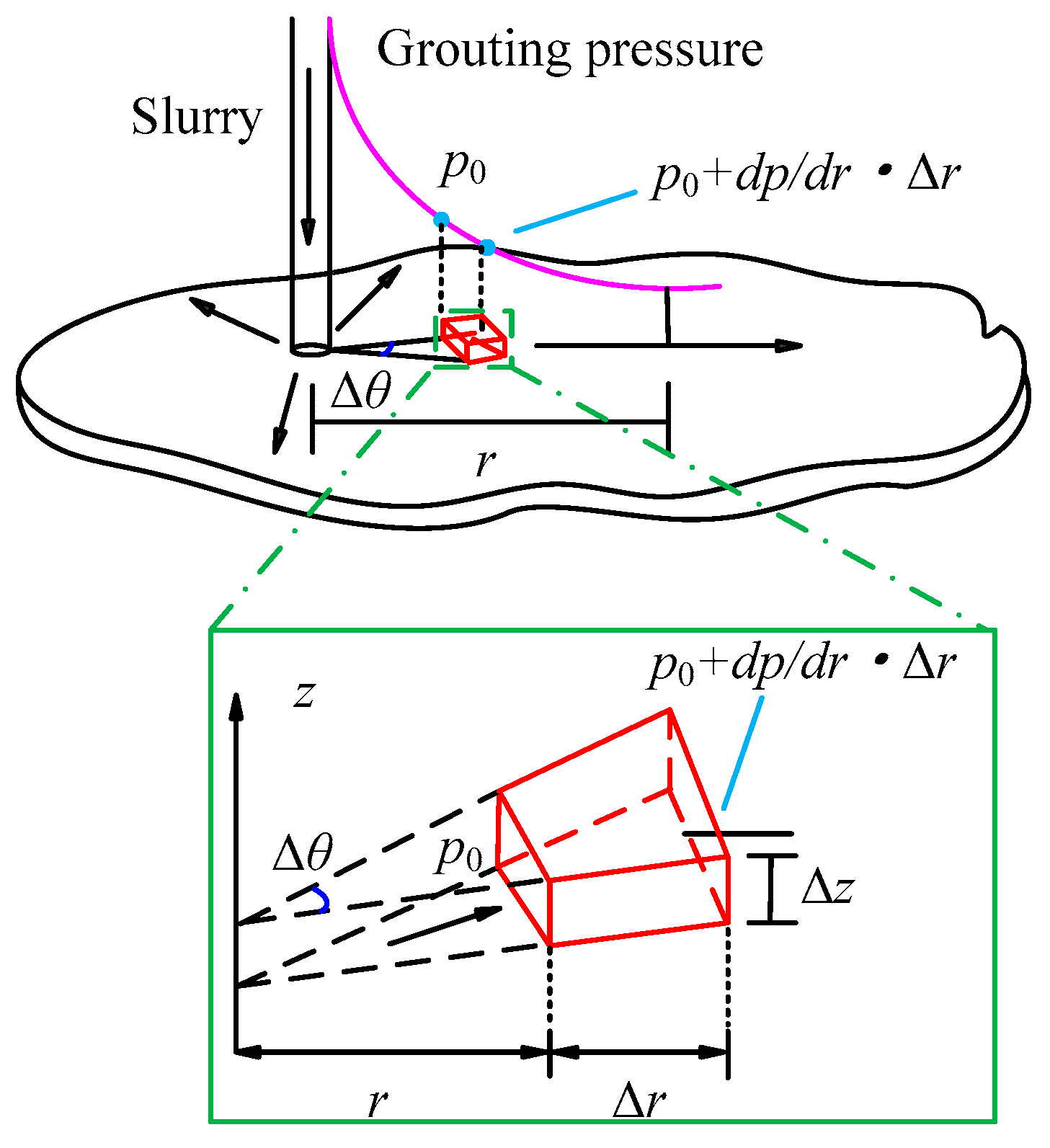




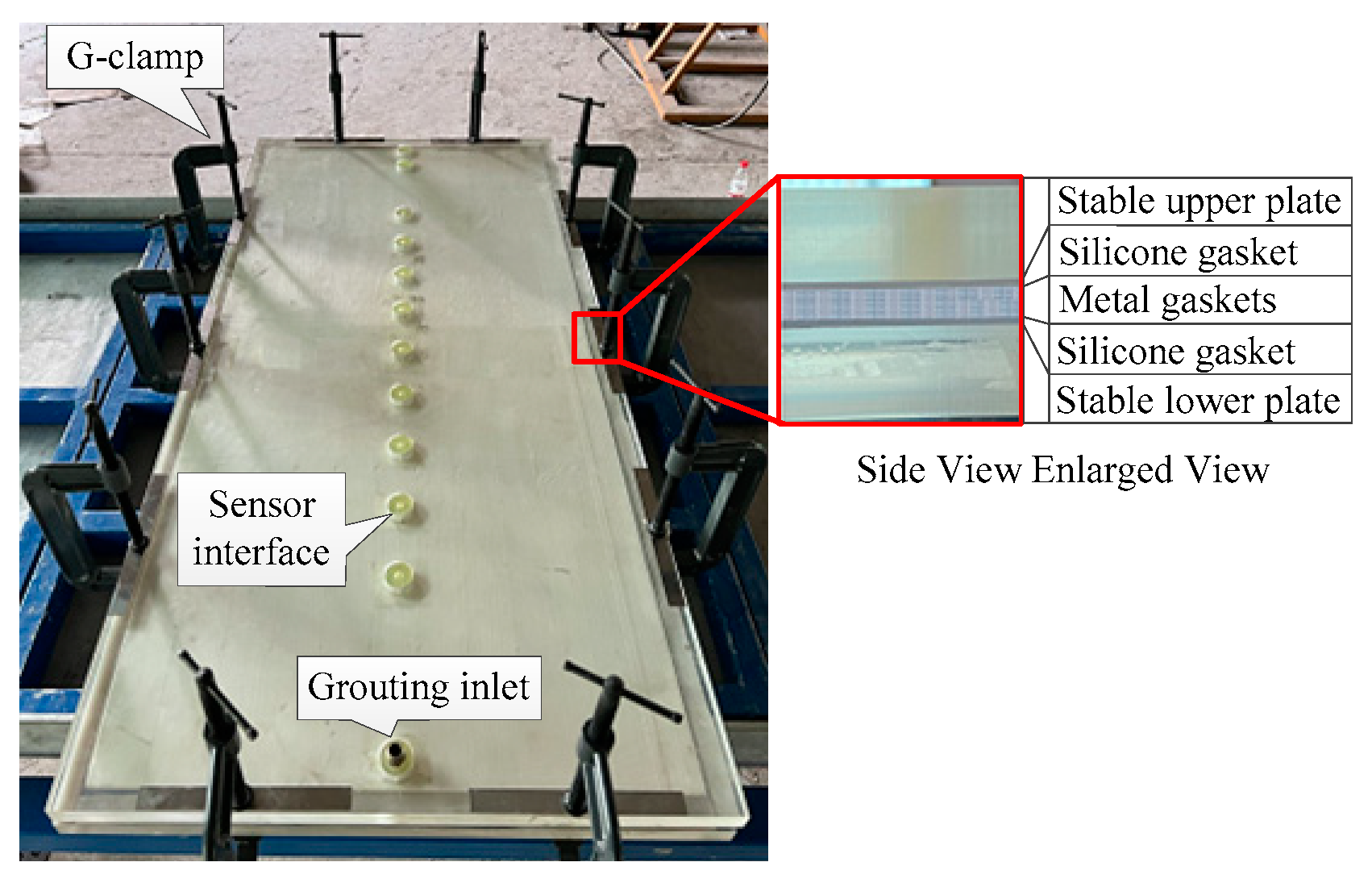
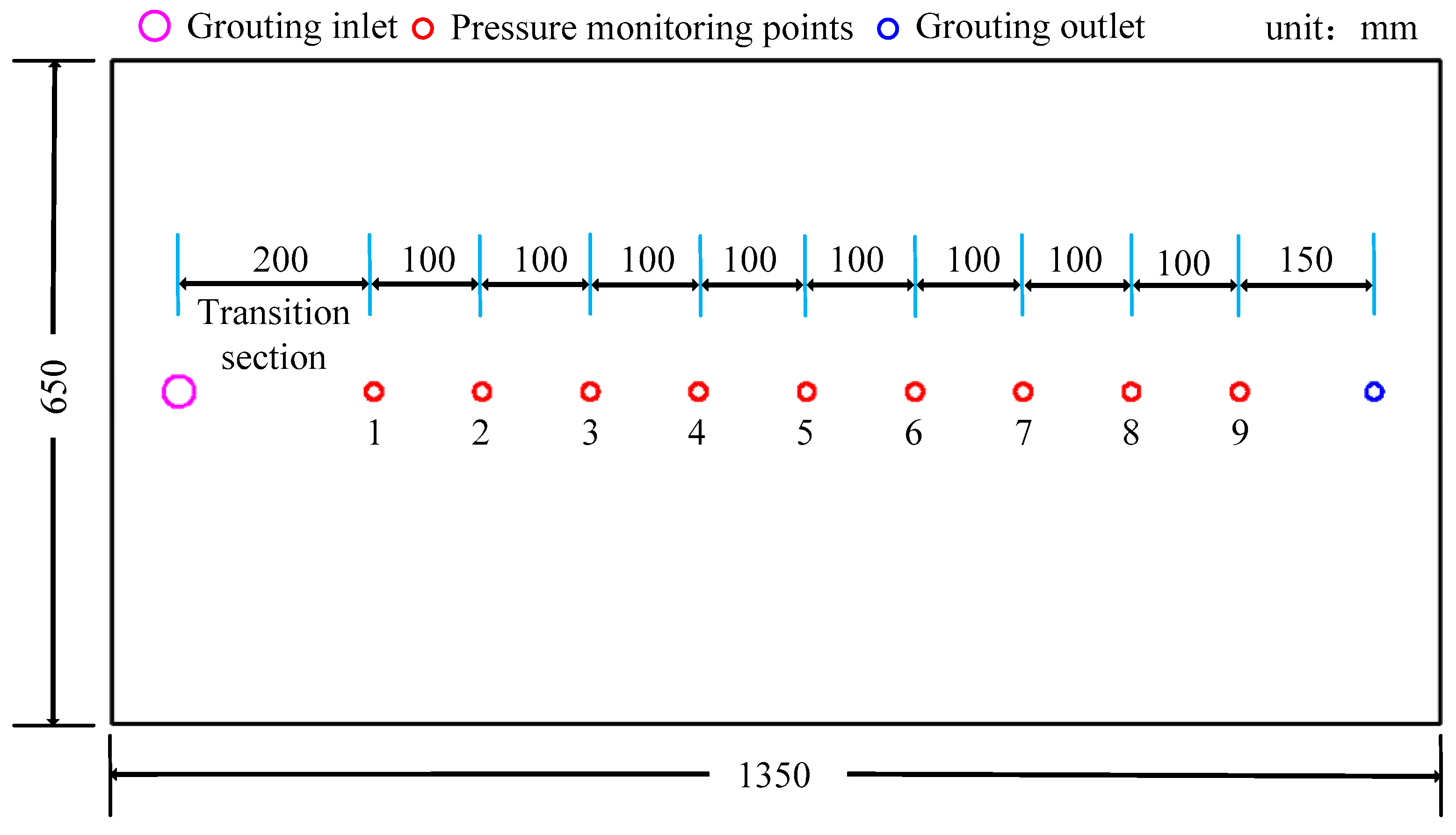
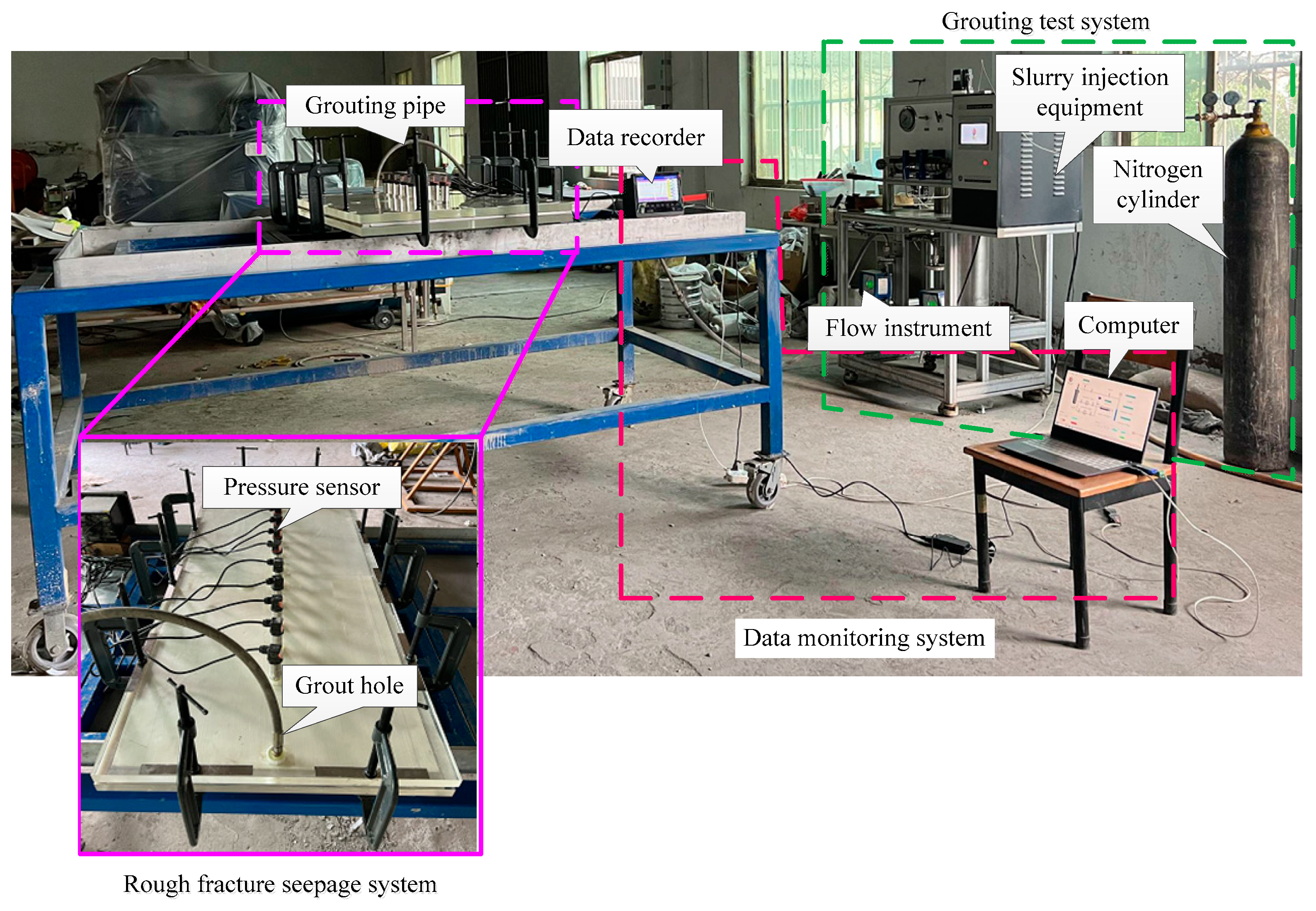

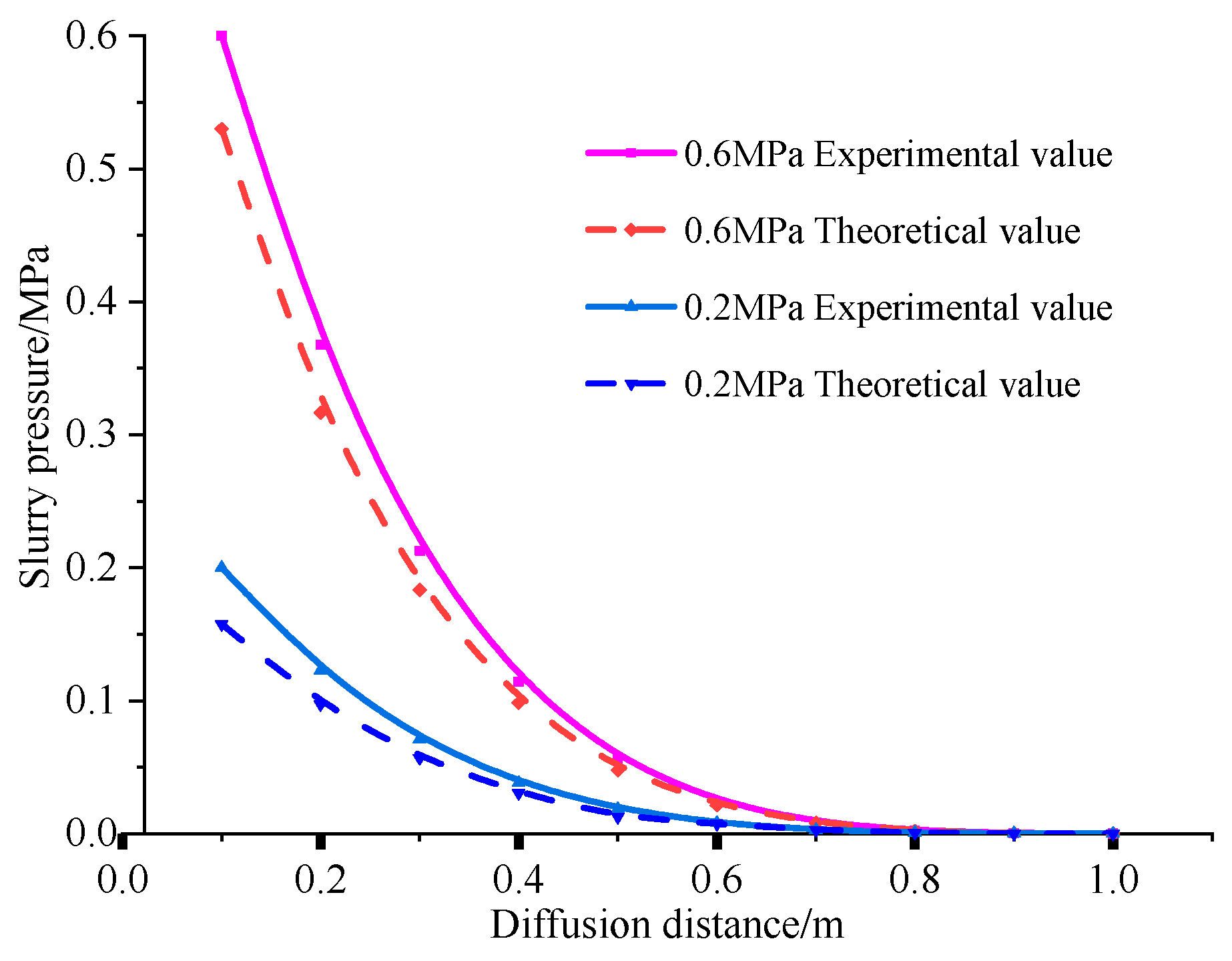

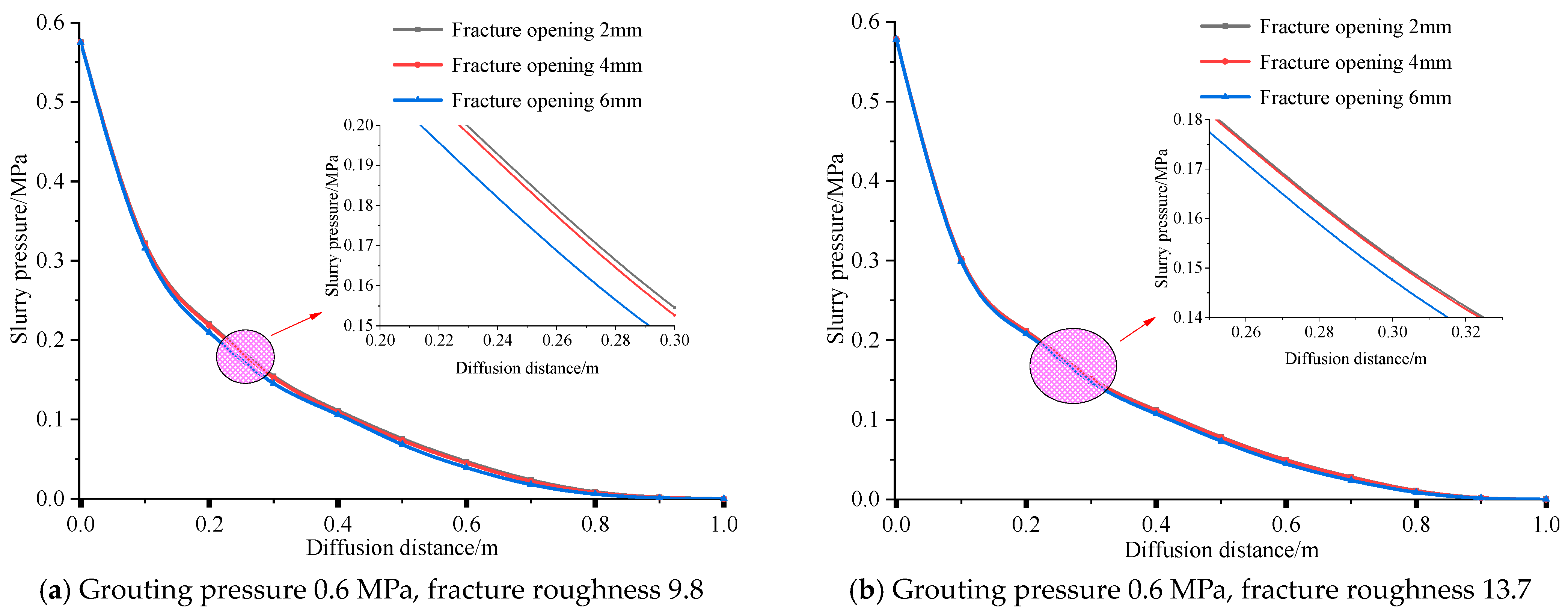
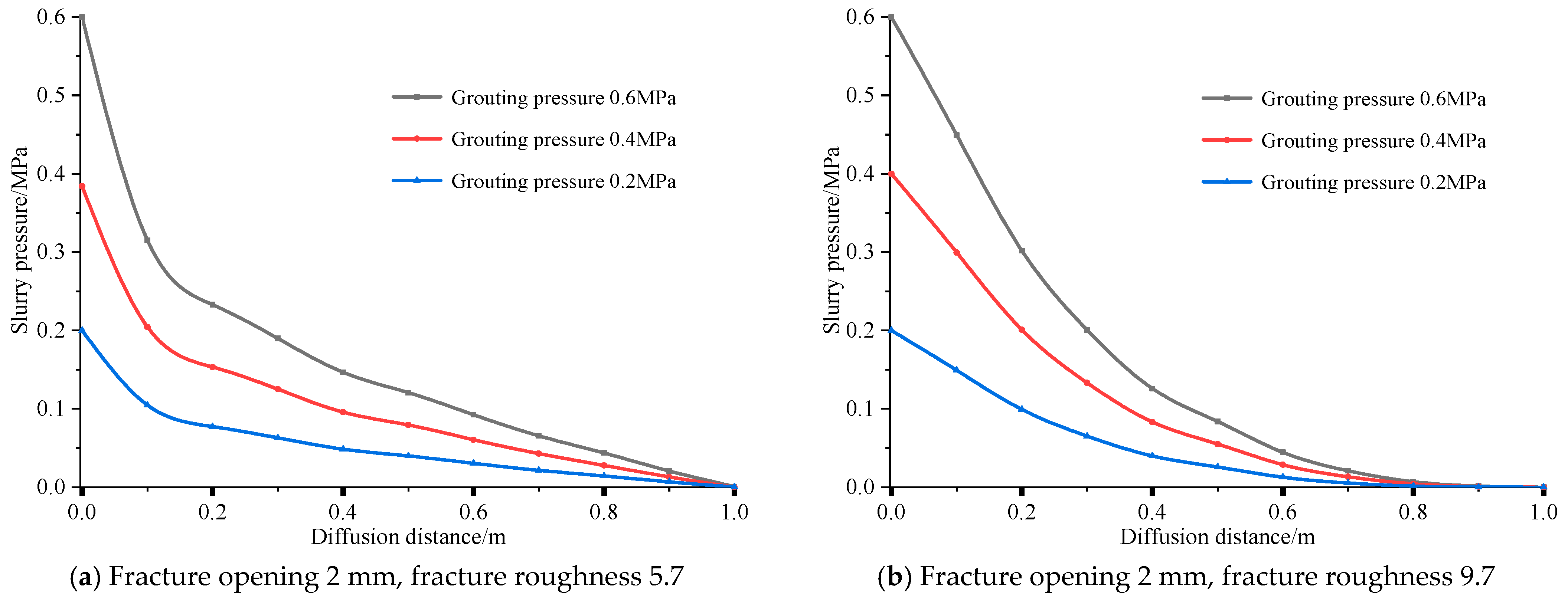


| Fracture Opening (mm) | Fracture Roughness | State | ||
|---|---|---|---|---|
| 0.2 MPa | 0.4 MPa | 0.6 MPa | ||
| 2 | 5.7 | |||
| 9.8 | √ | √ | √ | |
| 13.6 | ||||
| 17.3 | ||||
| 4 | 5.7 | |||
| 9.8 | √ | √ | √ | |
| 13.6 | ||||
| 17.3 | ||||
| 6 | 5.7 | |||
| 9.8 | √ | √ | √ | |
| 13.6 | ||||
| 17.3 | ||||
Disclaimer/Publisher’s Note: The statements, opinions and data contained in all publications are solely those of the individual author(s) and contributor(s) and not of MDPI and/or the editor(s). MDPI and/or the editor(s) disclaim responsibility for any injury to people or property resulting from any ideas, methods, instructions or products referred to in the content. |
© 2023 by the authors. Licensee MDPI, Basel, Switzerland. This article is an open access article distributed under the terms and conditions of the Creative Commons Attribution (CC BY) license (https://creativecommons.org/licenses/by/4.0/).
Share and Cite
Li, G.; Li, Z.; Du, F.; Cao, Z.; Wang, W. Development of Grouting Test System for Rough Fissure Rock Body and Research on Slurry Diffusion Law. Appl. Sci. 2024, 14, 47. https://doi.org/10.3390/app14010047
Li G, Li Z, Du F, Cao Z, Wang W. Development of Grouting Test System for Rough Fissure Rock Body and Research on Slurry Diffusion Law. Applied Sciences. 2024; 14(1):47. https://doi.org/10.3390/app14010047
Chicago/Turabian StyleLi, Guosheng, Zhenhua Li, Feng Du, Zhengzheng Cao, and Wenqiang Wang. 2024. "Development of Grouting Test System for Rough Fissure Rock Body and Research on Slurry Diffusion Law" Applied Sciences 14, no. 1: 47. https://doi.org/10.3390/app14010047
APA StyleLi, G., Li, Z., Du, F., Cao, Z., & Wang, W. (2024). Development of Grouting Test System for Rough Fissure Rock Body and Research on Slurry Diffusion Law. Applied Sciences, 14(1), 47. https://doi.org/10.3390/app14010047




